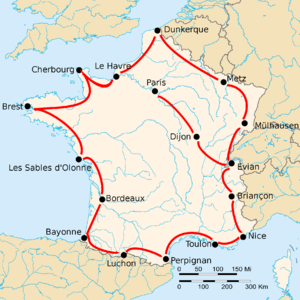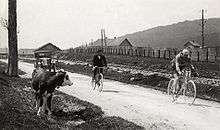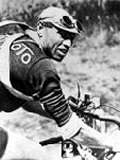1926 Tour de France
 | |||
| Route of the 1926 Tour de France Followed counterclockwise, starting in Evian, going counter-clockwise around France, and then to Paris. | |||
| Race details | |||
|---|---|---|---|
| Dates | 20 June – 18 July | ||
| Stages | 17 | ||
| Distance | 5,745 km (3,570 mi) | ||
| Winning time | 238h 44' 25" | ||
| Results | |||
| Winner | (Automoto–Hutchinson) | ||
| Second | (Alcyon–Dunlop) | ||
| Third | (Alcyon–Dunlop) | ||
The 1926 Tour de France was the 20th edition of the Tour de France, taking place from 20 June to 18 July. It consisted of 17 stages with a total distance of 5745 km, ridden at an average speed of 24.064 km/h.
The longest tour in history,[1] the route traced closely the borders of France. It was the first time that the race started outside Paris;[1] in this way riders were forced to climb the mountains in the east of the country twice, once at the beginning of the race, and again at the end.[2] The race was won by Belgian cyclist Lucien Buysse.
Changes from previous Tour
In 1925, the number of stages had been increased from 15 (which was common since 1910) to 18 stages. In 1926, this was decreased to 17 stages. Tour organiser Henri Desgrange wanted to have longer stages, so the average stage length increased from 312 km per stage in 1925 to 338 km per stage in 1926.[3]
Teams
There were 126 cyclists who started the Tour de France; 82 of them were touriste-routiers, cyclists who did not have the support from a team. The other 44 cyclists started the race in teams; some teams only had two cyclists.[4]
Pre-race favourites
The two teams with favourites were Automoto and Alcyon. The Automoto team had Ottavio Bottecchia, the winner of the last two editions of the race, and Lucien Buysse, the runner-up of the previous edition. The Alcyon team had Bartolomeo Aymo and Nicolas Frantz, third and fourth in 1925. They also had Adelin Benoit, and the Tour organisation thought that the battle would be between Bottecchia and Benoit.[3]
Race overview

Jules Buysse started strong in the first stage, by finishing solo with a margin of more than 13 minutes. The second stage ended with a bunch sprint, so nothing changed in the general classification. In the third stage, he lost the lead to Gustaaf van Slembrouck. On that day, Lucien Buysse received the news that his daughter had died. He considered to leave the race, but decided to stay.[3] The next stages all ended in bunch sprints, with all the favourites in the first group. In the sixth stage, Félix Sellier won the sprint. However, the jury decided that he had not sprinted according to the rules, and he was set back to second place, making Joseph van Dam the winner.[5]
The battle for the general classification seriously began in the tenth stage. That tenth stage was a tough stage, and has been labeled as the toughest stage ever in the Tour de France;[6] 76 cyclists started the race at midnight, and more than seventeen hours later, Lucien Buysse arrived as the winner. After twenty-five minutes, the next cyclist came in. After one hour, only 10 cyclists had finished, so the Tour de France organisation sent cars to look for the cyclists.[2] At midnight, 47 cyclists had arrived, some of them in buses.[7] The race officials decided to allow the cyclists 40% more time than the winning cyclist.[8] Later that night, 54 cyclists had crossed the finish line, and the remaining 22 cyclists were gathered; they were no longer in the race.[2] After the stage, the race officials were approached by a man who claimed that he had brought some cyclists to the finish line with his car, but that the cyclists had not paid him. The officials decided not to punish the cyclists, and paid the driver.[8] Gustaaf Van Slembrouck, wearing the yellow jersey as leader of the general classification, officially finished in 20th place, two hours behind Buysse. Year later, Van Slembrouck said that during the stage he had said to Tour organiser Desgrange that he was giving up, and Desgrange ordered a car to bring Van Slembrouck to the finish.[6] The same stage with the same mountains had also been in the 1913 Tour de France; then the weather was better, and winner Philippe Thys only took 13 hours to finish the stage.[2] One of the cyclists who had not finished the stage was the defending champion, Ottavio Bottecchia.[7]
When Buysse also won the next stage, his victory was assured,[7] as he was leading by more than one hour.[4] From that moment, Buysse saved his energy, and the race continued for the second place between Frantz and Aimo.[3] At the end of the race, Frantz was in second place, only 26 seconds before Aimo.
Results
In each stage, all cyclists started together. The cyclist who reached the finish first, was the winner of the stage. The time that each cyclist required to finish the stage was recorded. For the general classification, these times were added up; the cyclist with the least accumulated time was the race leader, identified by the yellow jersey.
Stage winners
In 1926, there were no French stage winners. This was the first time that this happened, and has since only happened again in 1999.[2]
| Stage | Date | Course | Distance | Type[n 1] | Winner | Race leader | |
|---|---|---|---|---|---|---|---|
| 1 | 20 June | Evian to Mülhausen | 373 km (232 mi) | | Plain stage | | |
| 2 | 22 June | Mülhausen to Metz | 334 km (208 mi) | | Plain stage | | |
| 3 | 24 June | Metz to Dunkerque | 433 km (269 mi) | | Plain stage | | |
| 4 | 26 June | Dunkerque to Le Havre | 361 km (224 mi) | | Plain stage | | |
| 5 | 28 June | Le Havre to Cherbourg | 357 km (222 mi) | | Plain stage | | |
| 6 | 30 June | Cherbourg to Brest | 405 km (252 mi) | | Plain stage | | |
| 7 | 2 July | Brest to Les Sables d'Olonne | 412 km (256 mi) | | Plain stage | | |
| 8 | 3 July | Les Sables d'Olonne to Bordeaux | 285 km (177 mi) | | Plain stage | | |
| 9 | 4 July | Bordeaux to Bayonne | 189 km (117 mi) | | Plain stage | | |
| 10 | 6 July | Bayonne to Luchon | 326 km (203 mi) | Stage with mountain(s) | | | |
| 11 | 8 July | Luchon to Perpignan | 323 km (201 mi) | | Stage with mountain(s) | | |
| 12 | 10 July | Perpignan to Toulon | 427 km (265 mi) | | Plain stage | | |
| 13 | 12 July | Toulon to Nice | 280 km (170 mi) | | Plain stage | | |
| 14 | 14 July | Nice to Briançon | 275 km (171 mi) | | Stage with mountain(s) | | |
| 15 | 16 July | Briançon to Evian | 303 km (188 mi) | | Stage with mountain(s) | | |
| 16 | 17 July | Evian to Dijon | 321 km (199 mi) | | Plain stage | | |
| 17 | 18 July | Dijon to Paris | 341 km (212 mi) | | Plain stage | | |
| Total | 5,745 km (3,570 mi)[1] | ||||||
General classification

The race was won by Belgian Lucien Buysse.
| Rank | Rider | Sponsor | Time |
|---|---|---|---|
| 1 | | Automoto–Hutchinson | 238h 44' 25" |
| 2 | | Alcyon–Dunlop | +1h 22' 25" |
| 3 | | Alcyon–Dunlop | +1h 22' 51" |
| 4 | | Armor–Dunlop | +1h 43' 54" |
| 5 | | Alcyon–Dunlop | +1h 49' 13" |
| 6 | | J.B. Louvet – Wolber | +1h 56' 15" |
| 7 | | Jean Louvet – Hutchinson | +2h 09' 20" |
| 8 | | Meteore–Wolber | +2h 28' 32" |
| 9 | | Automoto–Hutchinson | +2h 37' 03" |
| 10 | | Thomann–Dunlop | +2h 53' 54" |
| Final general classification (11–41) | |||
|---|---|---|---|
| Rank | Rider | Sponsor | Time |
| 11 | | J.B. Louvet – Wolber | +3h 09' 08" |
| 12 | | Automoto–Hutchinson | +4h 00' 35" |
| 13 | | Automoto–Hutchinson | +4h 07' 24" |
| 14 | | J.B. Louvet – Wolber | +4h 28' 19" |
| 15 | | Christophe–Hutchinson | +5h 23' 19" |
| 16 | | Christophe–Hutchinson | +6h 02' 20" |
| 17 | | Alcyon–Dunlop | +6h 03' 10" |
| 18 | | Jean Louvet – Hutchinson | +7h 10' 35" |
| 19 | | Meteore–Wolber | +7h 48' 17" |
| 20 | | Meteore–Wolber | +7h 49' 44" |
| 21 | | — | +8h 23' 29" |
| 22 | | Armor–Dunlop | +9h 37' 02" |
| 23 | | Meteore–Wolber | +9h 35' 44" |
| 24 | | — | +9h 36' 34" |
| 25 | | Thomann–Dunlop | +10h 05' 23" |
| 26 | | Labor–Dunlop | +10h 27' 05" |
| 27 | | — | +10h 30' 47" |
| 28 | | Labor–Dunlop | +10h 41' 09" |
| 29 | | — | +11h 26' 16" |
| 30 | | — | +11h 50' 56" |
| 31 | | — | +12h 56' 13" |
| 32 | | Meteore–Wolber | +13h 59' 59" |
| 33 | | — | +14h 24' 52" |
| 34 | | — | +15h 53' 32" |
| 35 | | — | +17h 12' 30" |
| 36 | | Meteore–Wolber | +18h 00' 43" |
| 37 | | — | +18h 18' 25" |
| 38 | | — | +19h 14' 17" |
| 39 | | — | +21h 00' 22" |
| 40 | | — | +22h 47' 44" |
| 41 | | — | +24h 59' 03" |
Other classifications
The race for touriste-routiers, cyclists who did not belong to a team and were allowed no assistance, was won by Italian Rossignoli.[12]
The organising newspaper, l'Auto named a meilleur grimpeur (best climber), an unofficial precursor to the modern King of the Mountains competition. This award was won by Lucien Buysse.[13]
Aftermath
Lucien Buysse announced after his win that he expected to win again in 1927, but because his sponsor Automoto had financial problems, they could not send a team to the Tours of 1927 and 1928, and Buysse only returned in 1929.[6] Lucien Buysse would never finish the Tour de France again. The winner of the previous edition, Bottecchia, said that he would retire from cycling, after the difficulties he faced in the 1926 Tour de France.
The Tour de France organisation did not like the outcome of the 1926 Tour de France, as 10 of the 17 stages had finished in bunch sprints. For the next year, the rules were changed, and the flat stages were run as team time trials.[3]
Notes and references
Footnotes
- ↑ There was no distinction in the rules between plain stages and mountain stages; the icons shown here indicate which stages included mountains.
References
- 1 2 3 Historical guide 2016, p. 108.
- 1 2 3 4 5 Tom James (15 August 2003). "1926: The longest Tour". VeloArchive. Retrieved 21 September 2009.
- 1 2 3 4 5 McGann, Bill; Mcgann, Carol (2006). The Story of the Tour De France Volume 1:1903-1964. Dog Ear Publishing. pp. 80–84. ISBN 1-59858-180-5. Retrieved 21 September 2009.
- 1 2 3 4 "20ème Tour de France 1926" (in French). Mémoire du cyclisme. Archived from the original on 6 March 2012. Retrieved 28 October 2016.
- ↑ "19ème Tour de France 1926 - 6ème étape" (in French). Mémoire du cyclisme. Archived from the original on 6 March 2012. Retrieved 28 October 2016.
- 1 2 3 Sierksma, Pieter (27 June 2006). "Tour de France / De zwaarste etappe ooit". Trouw (in Dutch). Retrieved 27 September 2010.
- 1 2 3 "Historique du Tour - 1926". Amaury Sport Organisation. Retrieved 21 September 2009.
- 1 2 "19ème Tour de France 1926 - 10ème étape" (in French). Mémoire du cyclisme. Archived from the original on 6 March 2012. Retrieved 28 October 2016.
- ↑ "Le Tour de France". Le Petit Journal (in French). Gallica Bibliothèque Numérique. 19 June 1926. p. 4. Retrieved 28 July 2010.
- ↑ Historical guide 2016, p. 24.
- ↑ Arian Zwegers. "Tour de France GC Top Ten". CVCC. Retrieved 21 September 2009.
- ↑ "l'Historique du Tour - Année 1926" (in French). Amaury Sport Organisation. Retrieved 15 January 2010.
- ↑ "Tour-giro-vuelta". Retrieved 21 September 2009.
Sources
- Augendre, Jacques (2016). Guide historique [Historical guide] (PDF). Tour de France (in French). Paris: Amaury Sport Organisation. Archived (PDF) from the original on 17 August 2016. Retrieved 27 October 2016.
External links
![]() Media related to 1926 Tour de France at Wikimedia Commons
Media related to 1926 Tour de France at Wikimedia Commons